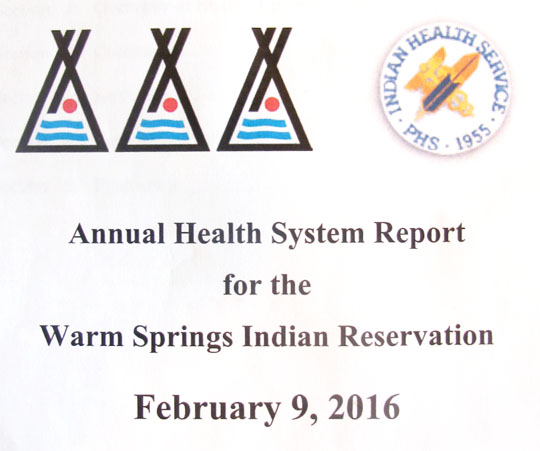Once every year Health and Human Services provides a comprehensive report on the state of tribal health, and the health care system. The report includes the most recent data compiled on tribal member health and health care services.
Health and Human Services Director Caroline Cruz in February presented the most recent report to Tribal Council. This article is the first in a series on the Annual Health System Report for the Warm Springs Indian Reservation.
There is some great news in the report, in regard to the overall health of the tribal membership. “The vital statistics of the tribal members have improved dramatically over the last few years,” the report says.
The report, for instance, looks at tribal members’ “years of productive life lost,” a way to measure premature deaths. Years of productive life lost (YPLL) among tribal members is the lowest ever recorded in Warm Springs, the report says.
“The YPLL number for the latest three-year period was nearly half of the number recorded in the previous three-year period. Corresponding infant mortality and early childhood death have decreased significantly.”
On another topic: For many years, teen pregnancies were averaging about 20 per year among tribal members. Then, in the most recent three-year period, the number decreased to an average of eight, a great improvement. (The 2016 health report was developed during 2015, so the latest figures are for the year 2014.)
Teen pregnancy is a youth risk factor. For instance, parenthood is the leading reason why teen mothers drop out of school. More than half of teen mothers never graduate from high school. Fewer than 2 percent graduate from college.
Some other information highlights from the report:
In the most recent three-year period, the leading causes of death among tribal members were cirrhosis, accidents and diabetes. These were the same leading causes as in the previous three years.
The report notes great improvement in the treatment and pre-treatment of diabetes among tribal members. The number of patients listed on the Diabetes Register declined from a high of 460 in 2012, to 402 in 2014.
Patients with controlled blood sugar have improved to 71 percent from 54 percent in 2012.
The number of hospitalization admissions remained about the same over the recent years, but the number of hospital days decreased by 5 percent.
Joint commission
Seven years ago the Confederated Tribes and the Indian Health Service entered into an agreement creating the Warm Springs Joint Health Commission.
The commission oversees the ongoing development of the health care system, and the implementation of the Joint Comprehensive Plan for the delivery of health services to the Warm Springs Reservation.
The tribal Health and Welfare Committee retains its role as liaison, helping to address community member access and concerns to the health system.
One major advantage of the tribal-IHS Joint Health Commission partnership is the ability to coordinate all health system efforts to better serve and educate the community.
The next article in this series will look at some of the health resources available to tribal members, and the most recent data regarding the services.


